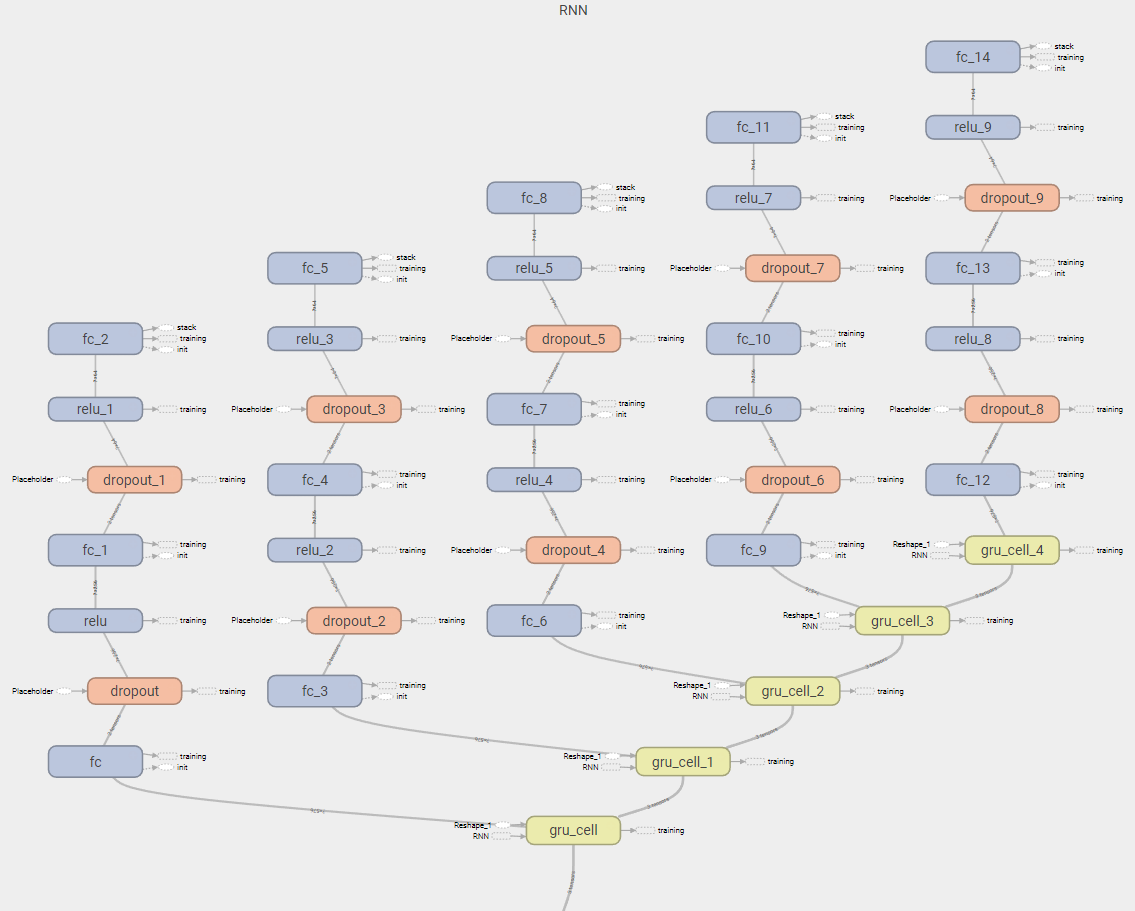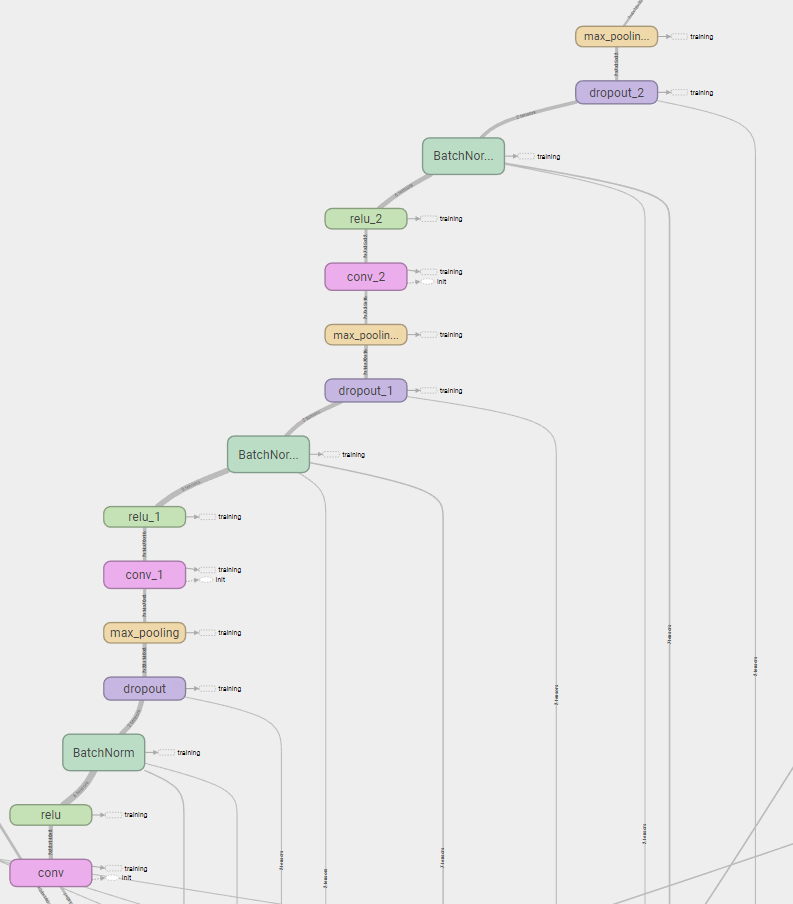Recognition of sequence of digits using tensorflow. All experiments, descriptions together with images of models and performances are described in Sequence of digits recognition.
Main file for single digit recognition is main_single_digit.py in the single_digit folder. Open the folder, choose model in the main method and run it by:
py -3 main_single_digit.py
You will need to create dataset of sequences of digits. The dataset is created by concatenation of mnist digits. The code for it is in the prepare_dataset.py. Run it by:
py -3 prepare_dataset.py
Three pickle files (train.p, validation.p, test.p) will be created containing training, validation and testing datasets.
The next step is to run main file for training of the sequence recognition models. Main file for it is main_sequence.py in the sequence_of_digits folder. Open the folder, choose the model in the main method and run the training by:
py -3 main_sequence.py
You will need to create dataset of sequences of digits. The dataset is created by concatenation of mnist digits. The code for it is in the prepare_dataset.py. Run it by:
py -3 prepare_dataset.py
Three pickle files (train_localization.p, validation_localization.p, test_localization.p) will be created containing training, validation and testing datasets.
The next step is to run main file for training of the sequence recognition models. Main file for it is main_sequence_localization.py in the sequence_of_digits_localization folder. Open the folder, choose the model in the main method and run the training by:
py -3 main_sequence_localization.py
You will need to create dataset of sequences of digits. The dataset is created by concatenation of mnist digits. The code for it is in the prepare_dataset.py. Run it by:
py -3 prepare_dataset.py
Three pickle files (train_variable_localization.p, validation_variable_localization.p, test_variable_localization.p) will be created containing training, validation and testing datasets.
The next step is to run main file for training of the sequence recognition models. Main file for it is main_sequences_variable_length.py in the sequences_of_variable_length folder. Open the file, choose the model in the main method and run the training by:
py -3 main_sequence_variable_length.py
This task uses real images of house numbers from Street View. Download dataset from http://ufldl.stanford.edu/housenumbers/ and place it into project's root. Run prepare_svhn_dataset.py by:
py -3 prepare_svhn_dataset.py
This will create folder SVHN_data containing prepared dataset. Use file SVHN_recognition/main_SVHN_recognition.py for training in the SVHN_recognition folder. Open the file, choose the model in the main method and run the training by:
py -3 main_SVHN_recognition.py
Single digit recognition uses Mnist dataset from tensorflow.
Single layer feedforward model is baseline model.
Two layers feedforward model mainly tests the connection of two layers.
Convolutional model containing three layers of convolution, relu and max pooling, followed by three fully connected layers.
Sequence of digits recognition uses dataset of digit sequences created by concatenation of digits from Mnist dataset. You can create the dataset as described in the section How to use.
Recurrent model uses the same convolutional layers as Convolutional model. The three fully connected layers are replaced by five times unrolled GRU units followed by single fully connected layer. Plus there is dropout after each convolutional layer which is not shown on the picture. You can disable it by setting keep_prob paramter to 1.0 in the main_sequence.py.
It is the improvement of the Recurrent model. The single fully connected output layer is replaced by three fully connected layers and relu activation functions. There is dropout between the first and the second, and second and the third. You can tune ropout by keep_prob parameter int he main_sequence.py. It achieves slightly better accuracy then the Recurrent model.
sequence_reshaped_convolution.py
It is model with same layers as sequence.py. The change is in the size of convolutions and number of their filters. The size of convolution is decreasing and the number of filters are increasing in the layers.
sequence_reshaped_convolution_batchnorm.py
It is model similar to sequence_reshaped_convolution.py and it adds batch normalization layers. This model achieves the best accuracy on the testing set. The convolutional part of the model is shown bellow.
sequence_reshaped_convolution_deeper.py
It is model adding the fourth convolutional layer to sequence_reshaped_convolution.py. The convolutional part of the model is shown bellow.
sequence_reshaped_convolution_batchnorm_double.py
It is model doubling the layers of the sequence_reshaped_convolution_batchnorm.py. The convolutional part of the model is shown bellow.
sequence_reshaped_convolution_batchnorm_stride.py
It is the same model as sequence_reshaped_convolution_batchnorm.py except the stride of max pooling layers. The max pooled regions are overlapped.
Sequence of digits recognition and localization uses dataset of digit sequences created by concatenation of digits from Mnist dataset. The digit sequences are placed on the random location of canvas. You can create the dataset as described in the section How to use.
The task is to correctly classify the sequence of numbers and to localize it. The location of sequence is defened by x, y coordinates and width and height of bounding box.
deep_localization_weighted_loss.py
Model able to learn the classification of sequences of digits and their localization. The loss function is
loss = 1000 * “classification loss (cross entropy)” + “localization error (meaned squared error)”
This is generalization of Sequence of digits recognition and localization. The task is to classify and to localize sequence of digits again, but the sequence has variable length this time. The maximal size of sequence is known. You can create the dataset as described in the section How to use.
deep_localization_weighted_loss_variable_length.py
This is the same model as deep_localization_weighted_loss.py. Only difference is the adaptation to output special "no digit" character.
deep_localization_weighted_loss_variable_length_deeper.py
This model is almost the same as deep_localization_weighted_loss_variable_length.py. Only difference is sixth convolutional layer.
This task is to recognize house numbers in real word images taken from Google Street View.
deep_localization_weighted_loss_variable_length.py
The same model as deep_localization_weighted_loss_variable_length.py, only difference is that it can output six digits instead of five.
This model is inspired by paper Multi-digit Number Recognition from Street View Imagery using Deep Convolutional Neural Networks. It also doesn't use reccurent recognition head. It uses six fully connected layers instead. Each for one digit.
svhn_paper_convolution_dropout_output.py
This model adds dropout before output layers of model svhn_paper_convolution.py.
svhn_transfer_learning_no_maxpool.py
This model replaces 2x2 max pooling layers by 2x2 convolutional layers with 2x2 stride.













